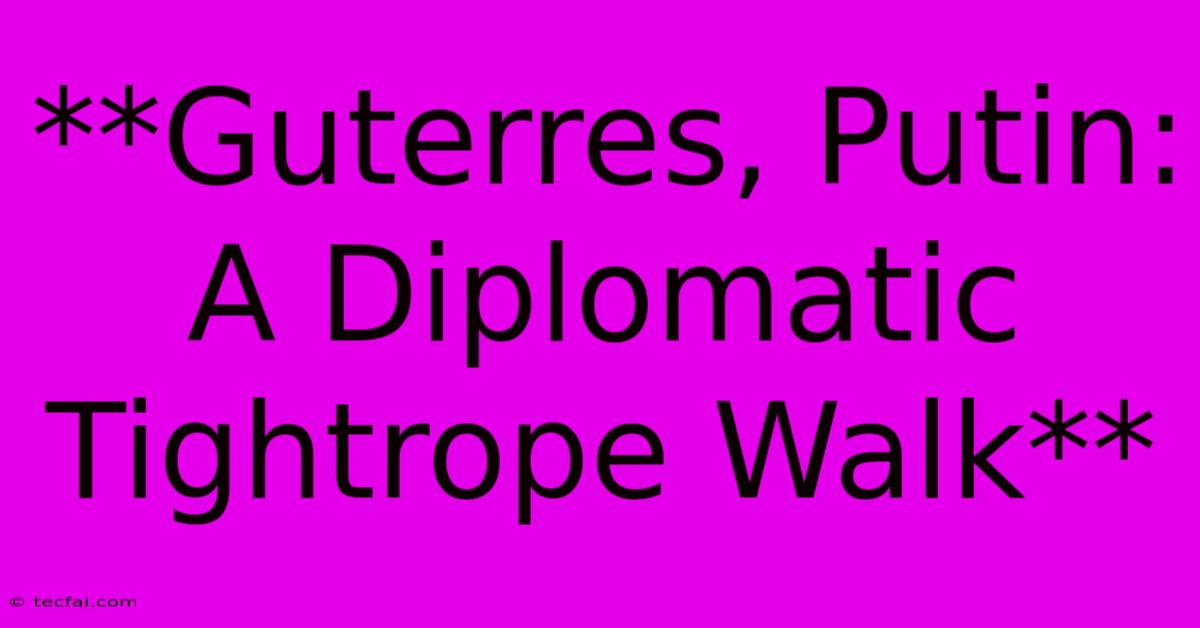**Guterres, Putin: A Diplomatic Tightrope Walk**

Discover more detailed and exciting information on our website. Click the link below to start your adventure: Visit Best Website tecfai.com. Don't miss out!
Table of Contents
Guterres, Putin: A Diplomatic Tightrope Walk
The ongoing war in Ukraine has thrown the world into a state of turmoil, pushing international relations to their limits. At the heart of this crisis lies a complex dance of diplomacy, with UN Secretary-General António Guterres and Russian President Vladimir Putin navigating a treacherous path between conflict and cooperation. This article delves into the delicate balancing act these two powerful figures are performing, analyzing the challenges and potential outcomes of their interactions.
A Meeting Under the Shadow of War
In April 2022, Guterres embarked on a high-stakes trip to Moscow, meeting with Putin to discuss the humanitarian situation in Ukraine. This meeting, while seemingly a step towards dialogue, was shadowed by the ongoing war and the deep political chasm between Russia and the West. Guterres emphasized the urgency of evacuating civilians from besieged Ukrainian cities, advocating for a humanitarian corridor. Putin, on the other hand, painted a narrative of Russia as a victim of Western aggression and justified his military actions as a necessary defense against NATO expansion.
The meeting underscored the stark differences in their respective narratives. While Guterres sought to establish a framework for peace, Putin remained steadfast in his justification for the war. The encounter, therefore, highlighted the immense difficulty of finding common ground amidst the starkly contrasting perspectives.
Navigating the Tightrope: The Challenges
The diplomatic dance between Guterres and Putin faces numerous challenges. The most prominent of these include:
- Divergent narratives: The fundamental disagreement over the causes and justifications of the war presents a significant obstacle. Russia's insistence on its own narrative, portraying itself as a victim of Western aggression, makes finding a shared understanding difficult.
- Shifting geopolitical landscape: The conflict has triggered a realignment of global powers, with Russia increasingly isolated from the international community. This dynamic adds complexity to the diplomatic process, as any potential solutions must navigate the shifting alliances and power dynamics.
- Humanitarian crisis: The unfolding humanitarian catastrophe in Ukraine further complicates the situation. The urgent need to provide aid and protect civilians adds pressure to the diplomatic efforts, demanding immediate action.
- Escalation of tensions: The potential for the conflict to escalate, perhaps even into a wider regional conflict, poses a constant threat. This heightened risk makes the search for a peaceful resolution even more critical, but also more fragile.
The Path Forward: A Search for Solutions
Despite the difficulties, Guterres and Putin's interactions offer a glimmer of hope for potential solutions. Both sides recognize the need to engage in dialogue, however limited, to address the humanitarian crisis and potentially explore avenues for peace.
Some potential avenues for progress include:
- Humanitarian corridors: Facilitating safe passage for civilians trapped in conflict zones, as well as ensuring the delivery of humanitarian aid to those in need.
- Prisoner exchanges: Engaging in negotiations to facilitate the release of prisoners of war and other detainees.
- Peace talks: Encouraging and facilitating negotiations between Russia and Ukraine, even if these discussions initially focus on limited aspects of the conflict.
Conclusion: A Balancing Act
The diplomatic tightrope walk between Guterres and Putin is an ongoing process, fraught with challenges and uncertainties. While the path to peace remains arduous, the willingness of both parties to engage in dialogue, albeit cautiously, offers a glimmer of hope. The international community, through the leadership of Guterres and other key players, must continue to exert pressure for a peaceful resolution and a path towards lasting peace. This delicate balancing act between conflict and cooperation holds the potential for a crucial shift in the trajectory of this crisis.

Thank you for visiting our website wich cover about **Guterres, Putin: A Diplomatic Tightrope Walk** . We hope the information provided has been useful to you. Feel free to contact us if you have any questions or need further assistance. See you next time and dont miss to bookmark.
Featured Posts
-
Daniel Lurie San Franciscos Next Mayor
Nov 09, 2024
-
Georgina Cooper Supermodel Passes Away At 46
Nov 09, 2024
-
How The Amsterdam Attacks Occurred
Nov 09, 2024
-
Pacers Guard Mc Connell Ruled Out For Friday
Nov 09, 2024
-
Dwp Petition 10 Christmas Bonus Increase
Nov 09, 2024
